Saturday, August 20, 2005
Æ antoninianus, Salonina, Mediolanum, Göbl 1374e
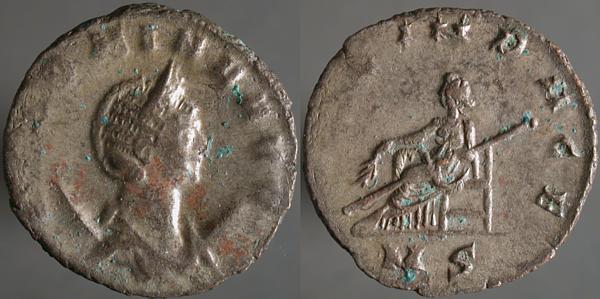
SALONINA AVG, Diademed draped bust right on crescent | AVG IN PACE, Salonina seated left holding olive branch left and long transverse scepter. MS in exergue.
A number of coins minted at Milan use this unusual reverse or a simple variant of it. It's only seen for this reign, and some people have been tempted, by the similarity to requiescat in pace, to imagine it as evidence for Salonina being a Christian.
While Gallienus, unlike his father, was notable for religious tolerance, there's no good reason to believe that any member of this imperial family predates Constantine's belief.
Friday, August 19, 2005
Æ28, Antioch in Pisidia, Gallienus, Lindgren & Kovacs A1258C
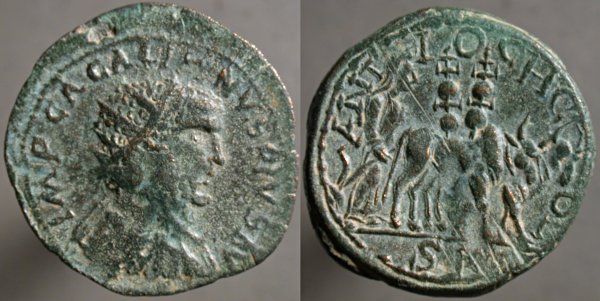
IMP CA GALIHNVS PIVS AV, Radiate draped cuirassed bust right | ANT_IOCH C_OL, Veiled founder of the colony with two oxen plowing right; behind, two standards. SR in exergue.
Scenes such as that shown on the reverse go back at least as far as Augustus. Plowing around the perimeter of a city was part of a founding ceremony. Here's a similar reverse on a coin of Philip II from Heliopolis (modern Baalbek.)
The seller attributed this as SNG Von Aulock 4984, which is correct, but missed this being the plate coin for Lindgren & Kovacs A1258C.
Thursday, August 18, 2005
Silvered Æ antoninianus, Salonina, Antioch, Göbl 1637e
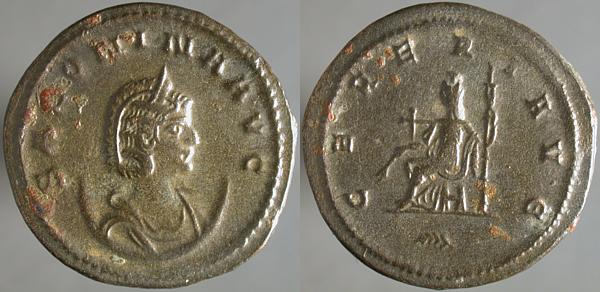
SALONINA AVG, Diademed draped bust right on crescent | CERERI AVG, Ceres seated left, holding scepter right and grain head left. Branch in exergue.
Ceres was a Roman grain goddess, related to the Greek Demeter. Associating her with the Empress seems wise, as nothing in the Roman food supply was more important than grain.
Wednesday, August 17, 2005
Silvered Æ antoninianus, Claudius II Gothicus, Antioch, RIC 225

IMP C CLAVDIVS AVG, Radiate draped cuirassed bust right | VIRTVS AVG, Minerva standing facing, head right, holding spear left and shield right, S in exergue.
Marcus Aurelius Claudius Gothicus became emperor after the death of Gallienus, in 268 CE, and continued battling the Goths. It's often thought that the importance of his victory at Naissus was intentionally confused with that of Gallienus at the Nestus by biographers hoping to please Constantine, who invented claims of Gothicus as his ancestor.
Claudius died in 270 of some contagion.
(He was probably involved in the assassination of Gallienus, who is the focus of my collection. I feel a certain fondness for Gallienus, and a lack of same for Claudius.)
Tuesday, August 16, 2005
Æ26, Coela in Thrace, Gallienus, Cohen 1363var (AEL MV COEL)
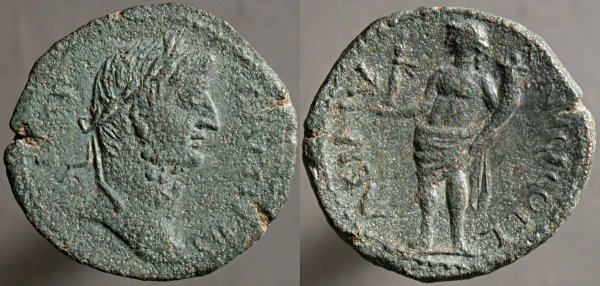
IMP GALLIENVS, Laureate head right | AEL MV_NICI COEL, Genius, head left, nude from the waist up, holding palladium left and cornucopiae right.
The second edition of Henry Cohen's Description Historique des monnaies frappées sous l'Empire Romain was published between 1880 and 1892. While it's not widely used today by English-speaking collectors, it remains popular in Europe, and remains useful as an additional source of information.
After a fruitless search for this coin in SNG Copenhagen, Sear Greek Imperial Coins, and Lindgren II and III, I thought to look in Cohen. While his books concentrate on Imperial coinage, they also cover provincial coins with Latin legends, such as this. The third coin on this page is like this coin, but is described with a more abbreviated reverse legend. (At the end of the description, F. indicates that there's an example in the French national collection, and M.B. that it's a "middle bronze", a bronze of medium denomination and size.)
The desciption there of the reverse isn't very helpful, failing to identify the figure, but a quick question at FORVM's Classical Numismatics Discussion Board confirmed my guess.
Monday, August 15, 2005
Æ as, Gallienus, Rome, Göbl 439c
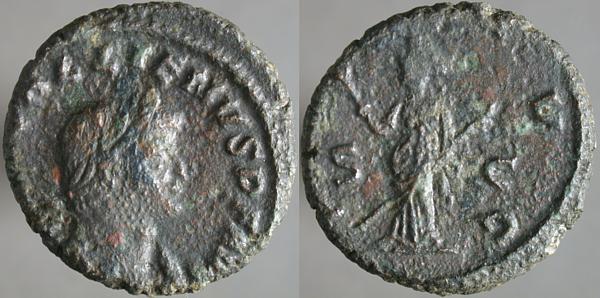
IMP GALLIENVS P F AVG, Laureate cuirassed bust right | PAX AVG, Pax standing facing, head left, holding branch left and long scepter transverse. S_C across fields.
A similar design to that on Saturday's coin, the as was a low-value bronze coin dating back to the Republic. While examples from the time of Valerian & Gallienus are uncommon, they do appear for sale every few months.
The dupondius was a similar coin, worth two ases, and I've yet to see a sale offer one of this family. I do sometimes see coins which aren't dupondii offered as such, sometimes by people who should know better.
Sunday, August 14, 2005
Æ tetradrachm, Alexandria, Valerian, Emmett 3705(6)

A K Π ΛI OVAΛEPIANOC EVEVC, Laureate draped cuirassed bust right | L_S, Eagle standing left, head right, wreath in beak. Regnal year across fields.
Issued a year after Friday's coin, this issue of Valerian Sr. features the same reverse design and very similar encrustation. It's possible that they weathered in the same soil, certainly in very similar soil, that's degraded some of the bronze of the coin into red, orange, and green compounds.

